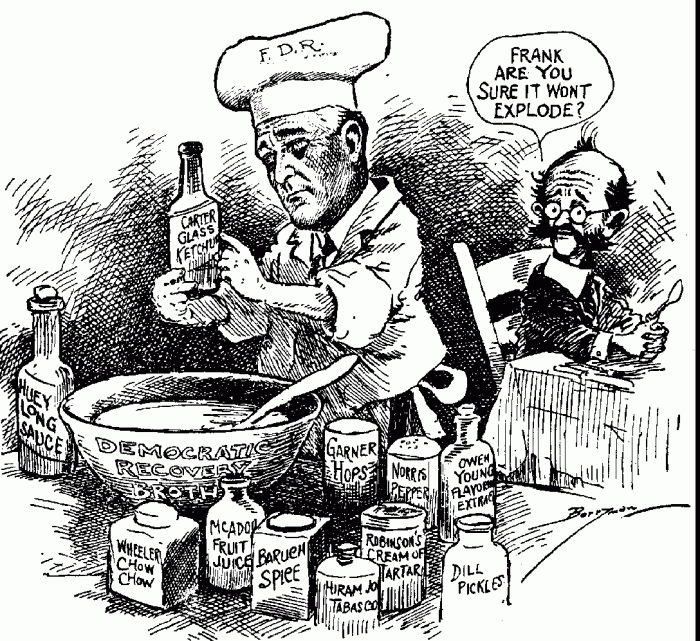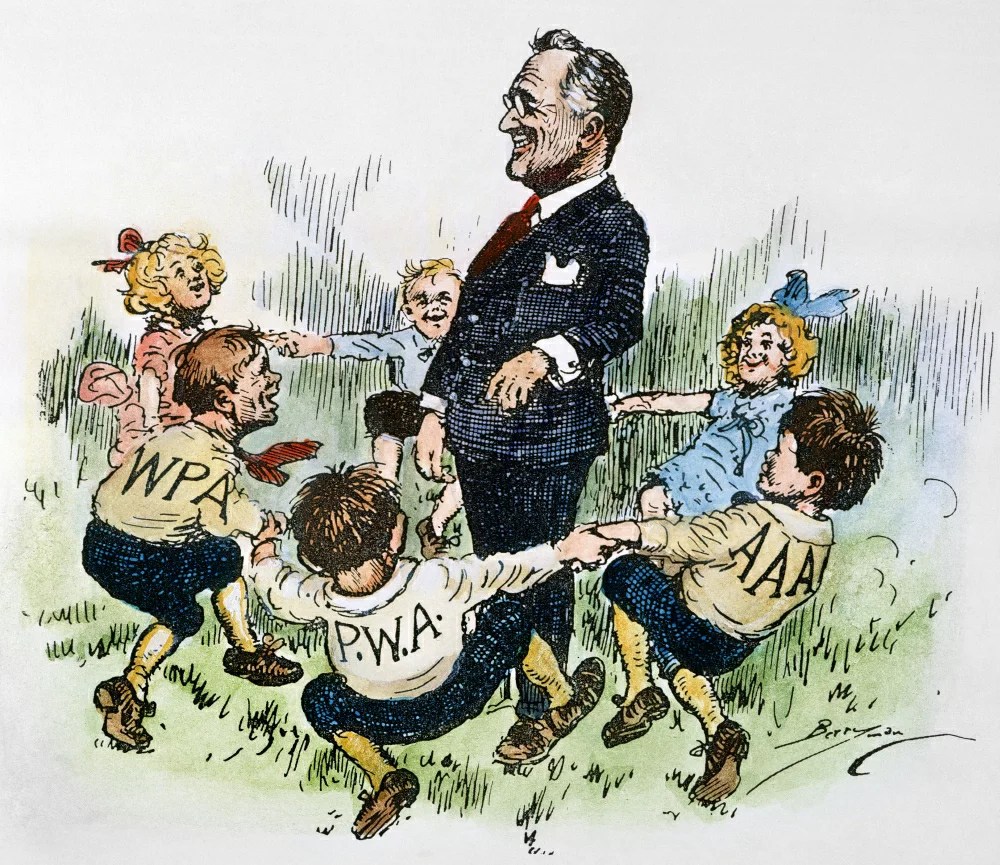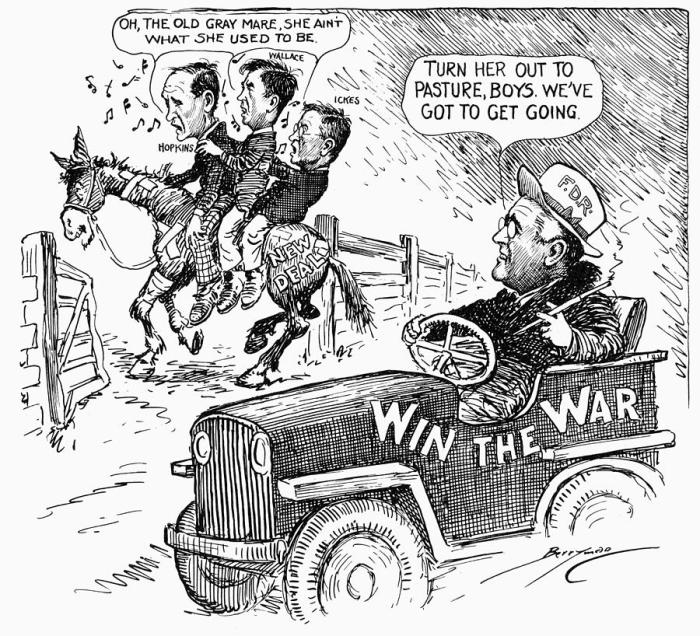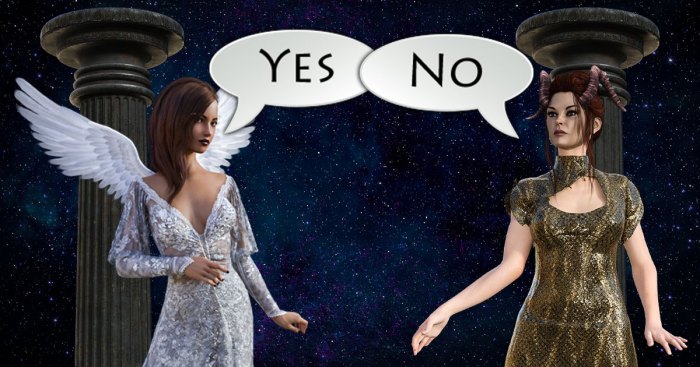The New Deal Remedies Political Cartoon is a powerful tool for understanding the social, economic, and political impact of the New Deal. These cartoons provide a unique perspective on the challenges and opportunities of the Great Depression and the New Deal’s response.
Political cartoons often use symbols, metaphors, and caricatures to convey their messages. By analyzing these elements, we can gain insights into the public’s perception of the New Deal and its impact on American society.
New Deal Programs
The New Deal, implemented during the Great Depression, was a series of economic programs and reforms enacted by President Franklin D. Roosevelt. These programs aimed to alleviate the widespread unemployment, poverty, and economic instability prevalent at the time.
The major New Deal programs fell under three main categories: relief, recovery, and reform. Relief programs provided immediate assistance to the unemployed and impoverished, while recovery programs sought to stimulate economic growth and create jobs. Reform programs aimed to address systemic economic issues and prevent future crises.
Relief Programs
- Civilian Conservation Corps (CCC): Provided employment and training for young men in conservation and infrastructure projects.
- Federal Emergency Relief Administration (FERA): Provided direct financial assistance to the unemployed and needy.
- Works Progress Administration (WPA): Created jobs in construction, arts, and other public works projects.
Recovery Programs
- National Industrial Recovery Act (NIRA): Established industry codes to regulate production and prices, and promoted labor unionism.
- Public Works Administration (PWA): Funded large-scale infrastructure projects, such as dams, bridges, and buildings.
- Agricultural Adjustment Act (AAA): Paid farmers to reduce crop production, aiming to raise agricultural prices.
Reform Programs
- Social Security Act: Established a national social insurance program providing retirement benefits, unemployment insurance, and aid to the disabled and elderly.
- Glass-Steagall Act: Separated investment banking from commercial banking, aiming to prevent future financial crises.
- Wagner Act: Protected the rights of workers to organize unions and bargain collectively.
Political Cartoon Analysis
Political cartoons during the New Deal era played a significant role in shaping public opinion and providing visual commentary on the policies and events of the time. These cartoons often employed powerful symbols, metaphors, and caricatures to convey their messages.
One common symbol used in New Deal cartoons was the figure of President Franklin D. Roosevelt. Roosevelt was often depicted as a benevolent leader, a savior figure who would rescue the nation from the depths of the Great Depression. He was also portrayed as a strong and decisive leader, standing up to the challenges facing the country.
Another common symbol in New Deal cartoons was the eagle. The eagle represented the United States and its strength and power. It was often used to symbolize the New Deal’s ambitious goals and its determination to overcome the challenges of the Depression.
Metaphors were also frequently used in New Deal cartoons. One common metaphor was the depiction of the New Deal as a ship. The ship represented the nation, and Roosevelt was often shown as the captain guiding it through stormy seas.
This metaphor conveyed the idea that the New Deal was a necessary and hopeful undertaking, despite the challenges it faced.
Caricatures were also a common feature of New Deal cartoons. These exaggerated and often humorous depictions of political figures served to highlight their strengths and weaknesses. Roosevelt was often caricatured as a larger-than-life figure, while his opponents were often depicted as small and insignificant.
Through their use of symbols, metaphors, and caricatures, New Deal cartoons provided a powerful and often humorous commentary on the events of the time. They helped to shape public opinion and to promote the New Deal’s goals.
Specific Cartoon Analysis
One of the most famous New Deal cartoons is “The New Deal,” drawn by Jay N. “Ding” Darling in 1934. The cartoon depicts Roosevelt as a giant figure, standing on a cliff overlooking a stormy sea. In his hands, he holds a ship labeled “The New Deal.”
The ship is being battered by the waves, but Roosevelt is holding it steady. In the background, the sun is rising, symbolizing hope for the future.
This cartoon conveys a powerful message of hope and optimism. It shows Roosevelt as a strong and capable leader, who is determined to guide the nation through the storm of the Depression. The rising sun in the background suggests that the New Deal will ultimately be successful in its goals.
Impact on American Society: New Deal Remedies Political Cartoon

The New Deal had a profound impact on American society, both socially and economically. It helped to alleviate the suffering caused by the Great Depression and laid the foundation for a more just and equitable society.
One of the most important social impacts of the New Deal was the creation of Social Security. Social Security provided a safety net for the elderly, the disabled, and the unemployed. It helped to reduce poverty and improve the quality of life for millions of Americans.
The New Deal also had a significant impact on the economy. It helped to stimulate economic growth and create jobs. The Works Progress Administration (WPA) employed millions of workers on public works projects, such as roads, bridges, and schools. The Civilian Conservation Corps (CCC) employed young men on conservation projects, such as planting trees and fighting forest fires.
The New Deal had a long-term legacy on American society. It helped to create a more just and equitable society by providing a safety net for the poor and the elderly. It also helped to stimulate economic growth and create jobs.
Historical Context

The New Deal was a series of economic programs and reforms implemented by President Franklin D. Roosevelt in the United States during the Great Depression. It was designed to alleviate the economic crisis, provide relief to the unemployed, and promote economic recovery.
The Great Depression, which began in 1929, was the worst economic crisis in American history. It caused a sharp decline in output, investment, and employment, leading to widespread poverty and hardship. By 1933, the unemployment rate had reached 25%, and millions of Americans were out of work.
Role of President Franklin D. Roosevelt
Franklin D. Roosevelt was elected President in 1932 on a platform promising to implement a “New Deal” for the American people. Roosevelt believed that the government had a responsibility to intervene in the economy to promote recovery. He proposed a series of bold programs and reforms designed to stimulate the economy, create jobs, and provide relief to the unemployed.
Economic Remedies

The New Deal introduced a range of economic remedies aimed at addressing the severe economic crisis of the Great Depression. These remedies included fiscal and monetary policies, as well as regulatory reforms.
Fiscal policies focused on increasing government spending and reducing taxes to stimulate economic growth. Monetary policies involved expanding the money supply and lowering interest rates to encourage borrowing and investment. Regulatory reforms aimed to stabilize the financial system and prevent future crises.
Effectiveness of Economic Remedies
The effectiveness of these remedies in addressing the economic crisis is a subject of ongoing debate among historians and economists. Some argue that the New Deal policies helped to end the Depression, while others maintain that the economy recovered despite, rather than because of, government intervention.
There is evidence to support both sides of this argument. On the one hand, the New Deal did lead to a significant increase in economic activity. GDP grew by 50% between 1933 and 1939, and unemployment fell from 25% to 14%. On the other hand, the economy did not fully recover until after the United States entered World War II in 1941.
Successful and Unsuccessful Economic Measures
Among the most successful New Deal economic measures were the Social Security Act, which provided old-age pensions, unemployment insurance, and aid to families with dependent children; the National Labor Relations Act, which protected the rights of workers to organize and bargain collectively; and the Federal Deposit Insurance Corporation, which insured bank deposits up to $5,000.
Some of the less successful New Deal economic measures included the National Recovery Administration, which attempted to set prices and wages for various industries; the Agricultural Adjustment Act, which paid farmers to reduce production; and the Public Works Administration, which funded construction projects.
Political Consequences
The New Deal had significant political consequences, reshaping the American political landscape and playing a crucial role in the development of the modern American welfare state.
The New Deal programs and policies strengthened the power of the federal government, expanding its role in the economy and social welfare. This shift towards a more centralized and interventionist government marked a departure from the traditional laissez-faire approach that had characterized American politics.
Impact on the American Political Landscape, New deal remedies political cartoon
- Increased Federal Power:The New Deal programs, such as the Social Security Act and the National Labor Relations Act, expanded the scope of federal authority, giving the government a greater role in regulating the economy and protecting the rights of workers.
- Growth of the Democratic Party:The New Deal policies, which were largely supported by the Democratic Party, helped to strengthen the party’s base and expand its electoral appeal. The Democrats became associated with the New Deal’s social welfare programs, which resonated with working-class and low-income voters.
- Decline of the Republican Party:The Republican Party, which had traditionally been the dominant party in American politics, suffered a decline in support during the New Deal era. The party’s opposition to many of the New Deal programs alienated many voters, leading to a loss of political power.
Role in Shaping the Modern American Welfare State
The New Deal laid the foundation for the modern American welfare state, establishing a system of social welfare programs that provided economic security and protection for vulnerable populations.
- Social Security:The Social Security Act of 1935 established a national pension system, providing retirement benefits to workers and their families.
- Unemployment Insurance:The Social Security Act also established a system of unemployment insurance, providing temporary income support to workers who lost their jobs.
- Aid to Families with Dependent Children (AFDC):The Social Security Act created the Aid to Families with Dependent Children program, providing financial assistance to low-income families with children.
These programs, along with other New Deal initiatives, helped to create a safety net for the American people, reducing poverty and providing a measure of economic security during times of economic hardship.
FAQ Explained
What are the major themes depicted in New Deal Remedies Political Cartoons?
Common themes include economic recovery, social welfare, political reform, and the role of government.
How can political cartoons help us understand the impact of the New Deal?
Political cartoons provide a unique perspective on the public’s perception of the New Deal and its impact on American society.
What are some of the most famous New Deal Remedies Political Cartoons?
Some famous examples include “The New Deal: A New Day for America” by Clifford Berryman and “The Road to Recovery” by Jay Norwood Darling.
